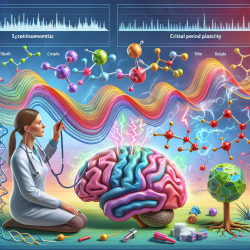Introduction
In the realm of neurodevelopment, the concept of critical period plasticity is pivotal. These are windows of time during which the brain is particularly receptive to environmental influences, allowing for the refinement of neural circuits essential for cognitive functions. However, emerging research highlights a growing concern: the potential disruption of these critical periods by environmental chemicals. The study titled Systematic Analysis of Environmental Chemicals That Dysregulate Critical Period Plasticity-Related Gene Expression Reveals Common Pathways That Mimic Immune Response to Pathogen sheds light on this pressing issue.
Understanding the Research
The research employs an integrative bioinformatics approach to systematically analyze the impact of environmental chemicals on critical period plasticity. By scanning 2001 environmental chemicals, the study identifies 50 that consistently dysregulate gene expressions related to critical period plasticity. These chemicals span categories such as pesticides, antimicrobials, metals, and anesthetics.
One of the key findings is the identification of common pathways that mimic immune responses to pathogens. This suggests that exposure to these chemicals could trigger inflammatory pathways, potentially disrupting the delicate balance required for normal neurodevelopment.
Implications for Practitioners
For practitioners in the field of speech-language pathology, this research underscores the importance of considering environmental factors in assessments and interventions. Here are a few ways practitioners can apply these findings:
- Awareness and Education: Educate parents and caregivers about the potential impact of environmental chemicals on neurodevelopment. Encourage them to minimize exposure to identified harmful chemicals.
- Holistic Assessments: Incorporate questions about environmental exposures in case histories. This can provide a more comprehensive understanding of factors that might influence a child's development.
- Collaborative Approaches: Work with other professionals, such as pediatricians and environmental health specialists, to address environmental factors that may affect a child's development.
Encouraging Further Research
While the study provides a foundational understanding, it also opens avenues for further research. Practitioners are encouraged to explore the following areas:
- Longitudinal Studies: Conduct studies that track the long-term impact of early exposure to environmental chemicals on language and cognitive development.
- Intervention Strategies: Develop and test intervention strategies aimed at mitigating the effects of chemical exposure during critical periods.
- Cross-Disciplinary Research: Collaborate with researchers in environmental science, neuroscience, and public health to deepen the understanding of how environmental factors influence neurodevelopment.
Conclusion
The research presented in the study highlights a critical intersection between environmental science and neurodevelopment. For practitioners, it serves as a call to integrate environmental considerations into practice and to advocate for research that further elucidates these complex interactions. By doing so, we can better support the developmental trajectories of children, ensuring that they have the best possible outcomes.
To read the original research paper, please follow this link: Systematic Analysis of Environmental Chemicals That Dysregulate Critical Period Plasticity-Related Gene Expression Reveals Common Pathways That Mimic Immune Response to Pathogen.










